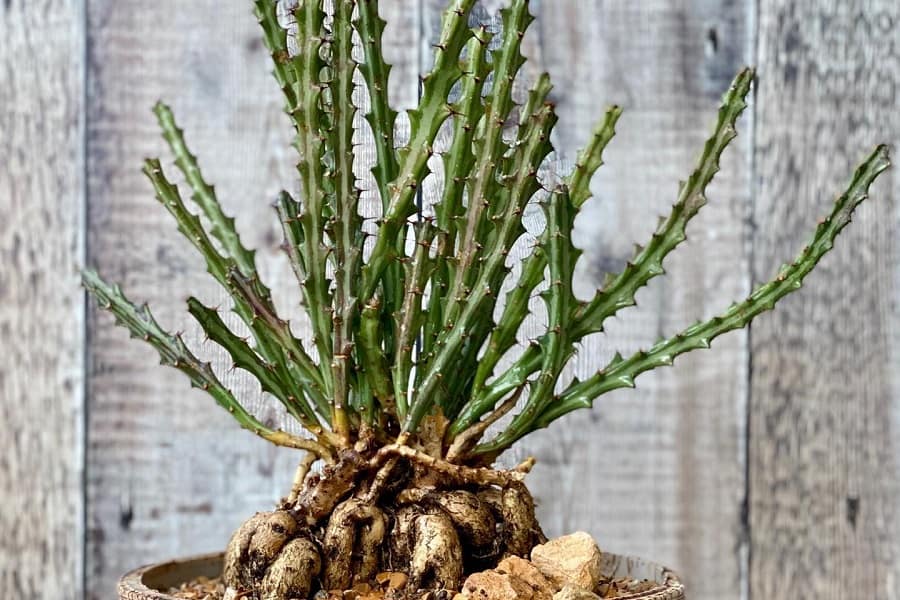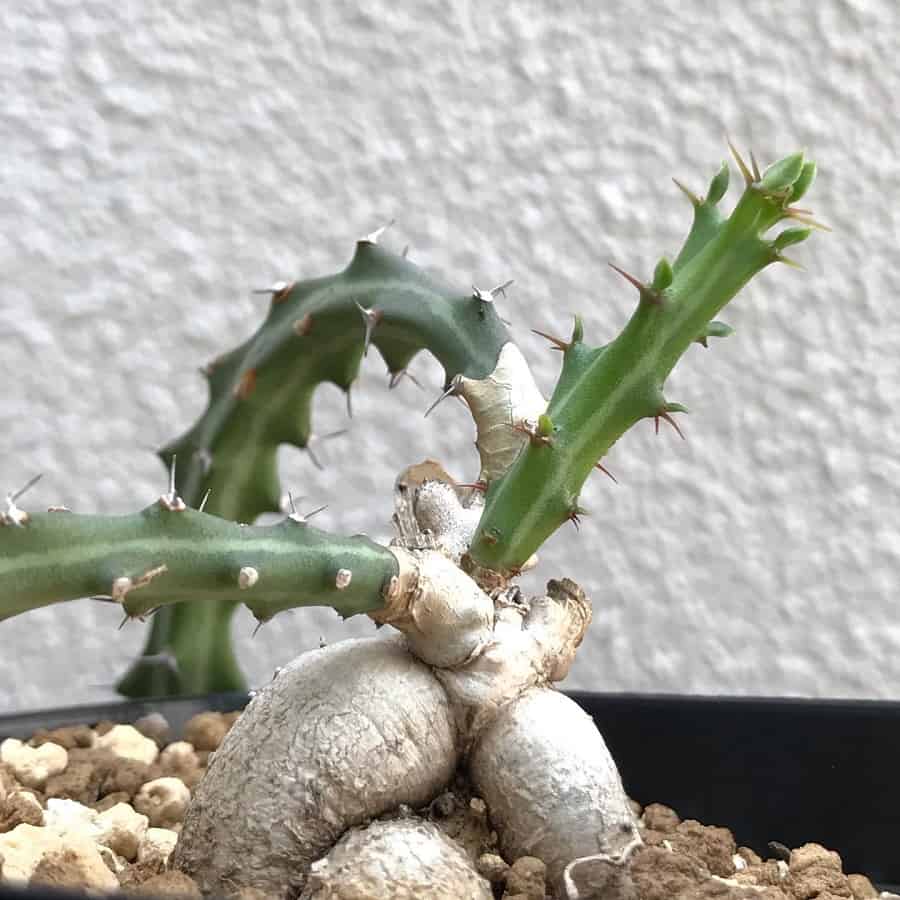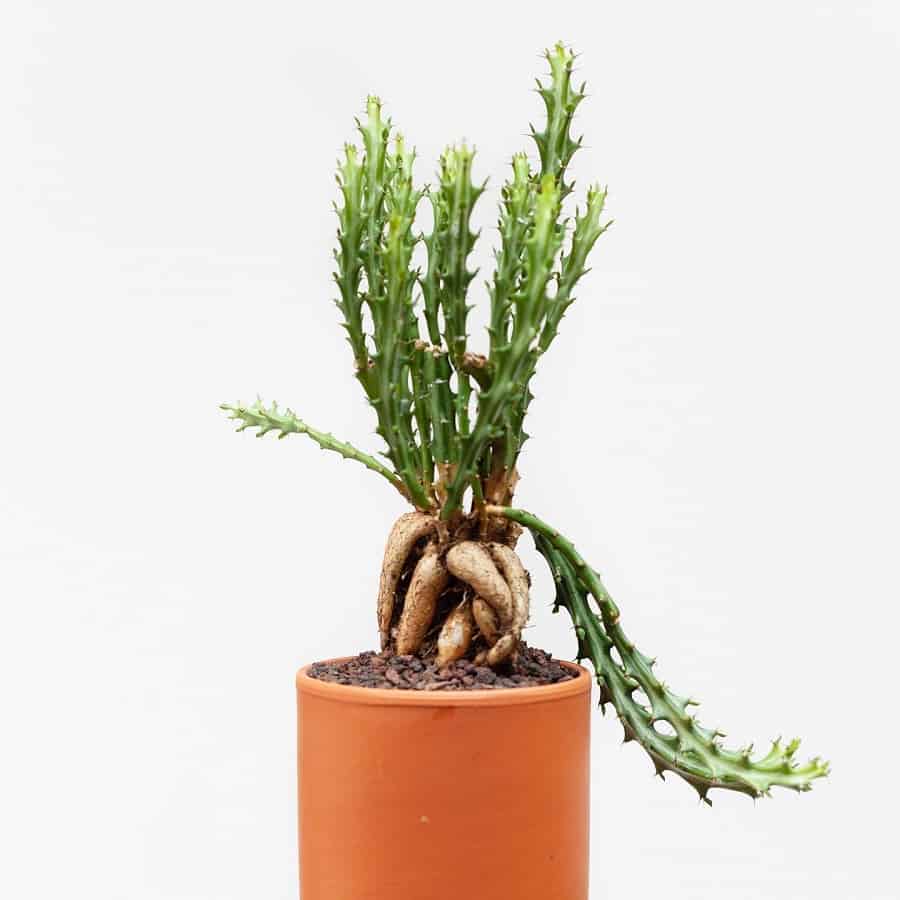Euphorbia knuthii: Characteristics and Care
At first glance, Euphorbia knuthii might fool you into thinking it’s a quirky cactus relative. With its thick, gnarly caudex (plant stem) up to 13 inches in diameter forming the base, and ridged, spiny branches splaying outwards, this succulent shrub has an otherworldly, almost alien appearance. But don’t be fooled by its cactus-like disguise – Euphorbia knuthii is a fascinating plant with its own unique charm and cultivation needs. Read on to unveil the secrets of this desert eccentric.

Contents
About Euphorbia knuthii
Native to the semi-arid, rocky regions of South Africa, Euphorbia knuthii is a shrubby succulent that can reach up to 3 feet tall when mature. Its most distinctive feature is the swollen, contorted caudex that forms the base, allowing the plant to store water like a reservoir. The branches are covered in ridges and spines, giving them an artfully sculptural look. With their tendency to trail downwards rather than grow upright, these plants make striking additions to hanging baskets or wall gardens.
Related Post:
200 Types of Euphorbia With Pictures
Euphorbia knuthii Care Guide
Light Requirements
Euphorbia knuthii thrives in full sun, needing at least 6 hours of direct sunlight daily. In hot climates, some afternoon shade may be beneficial to prevent leaf scorching. Indoors, position your plant near a sunny, south-facing window. If natural light is insufficient, invest in a quality grow light designed for succulents to supplement lighting needs.
Watering Needs
Euphorbia knuthii is drought-tolerant, so take care not to over-water. During spring to fall growth, allow the top 2-3 inches of soil to fully dry out between thorough waterings, which will be roughly every 7-10 days.
In winter dormancy, reduce watering significantly to once a month or just enough to prevent shriveling. Always water in the morning to allow moisture to evaporate from the plants before night.

Soil Preferences
Like most succulents, Euphorbia knuthii does best in a well-draining soil mix. The ideal blend contains equal parts potting soil and coarse sand or perlite to increase drainage and aeration. Or, simply use a quality commercial succulent soil mix for foolproof results.
Fertilizing Tips
While not heavy feeders, an occasional dose of succulent fertilizer during the spring to fall growing season will give your Euphorbia knuthii a nutritional boost. Choose a balanced liquid fertilizer diluted to half strength. Slow-release granular fertilizers are another low-maintenance option. Hold off on feeding during winter dormancy.
Temperature and Humidity
These plants prefer reasonably warm, dry conditions. Daytime temperatures from 70-90°F and nighttime around 55-65°F are ideal. Euphorbia knuthii can tolerate periods of low humidity but does appreciate around 50% relative humidity if possible.
Pests and Problems
Two common pests to watch for are spider mites and mealybugs, which can quickly infest the plant if left unchecked. Use insecticidal soaps, neem oil or other succulent-safe remedies at the first sign of trouble.
Pruning
Regular pruning isn’t strictly necessary, but you can trim off elongated, unsightly growth as needed to maintain the plant’s compact shape and aesthetics.

Potting and Repotting
When potting or repotting, ensure the container has ample drainage holes and use a well-draining cactus/succulent soil. Allow the caudex to rest slightly above the soil line. Repot every 2-3 years in spring.
Euphorbia knuthii Propagation Methods
This unique plant can be propagated from either seeds or stem cuttings:
Seeds:
- Use a half-and-half mix of commercial seed starter and coarse sand
- Sow seeds on the surface and lightly cover with sand
- Keep soil warm (around 75-85°F) and moderately moist
- Be patient – germination can take 2 weeks to 6 months
Stem Cuttings:
- Take 4-6 inch stem tip cuttings with a sharp, sterile knife
- Allow cuttings to callus over for several days before replanting
- Plant cuttings in well-draining cactus/succulent mix
- Water sparingly until roots form
With its captivating, alien-like appearance and easy-care nature, Euphorbia knuthii makes an excellent addition to homes or gardens – a living, sculptural masterpiece disguised as a cactus! Give this hardy succulent a try for low-maintenance texture and whimsy.
